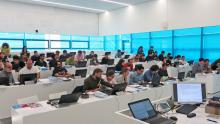Learning Modelling and Artificial Intelligence
Artificial intelligence (AI) is a rapidly growing interdisciplinary field, driven in particular by proven successes in image processing and natural language handling. successes in image processing and natural language processing. In its entirety, it offers the In general, it offers the possibility of responding to a strong need of industrialists who are seeking to make the best use of data. This may involve gaining a better understanding of complex systems or predicting their behaviour, with the aim of increasing the competitiveness of companies.





